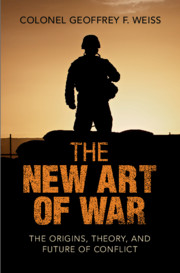Book contents
- The New Art of War
- The New Art of War
- Copyright page
- Dedication
- Contents
- Figures
- Preface
- Acknowledgments
- Introduction: Why Study War?
- 1 The Origins of War
- 2 The Masters of War Theory and Strategy
- 3 Small Wars and Domain Theory
- 4 The Unified War Theory
- 5 The Future of War
- Conclusion
- Appendix
- Notes
- Bibliography
- Index
1 - The Origins of War
Published online by Cambridge University Press: 12 August 2021
- The New Art of War
- The New Art of War
- Copyright page
- Dedication
- Contents
- Figures
- Preface
- Acknowledgments
- Introduction: Why Study War?
- 1 The Origins of War
- 2 The Masters of War Theory and Strategy
- 3 Small Wars and Domain Theory
- 4 The Unified War Theory
- 5 The Future of War
- Conclusion
- Appendix
- Notes
- Bibliography
- Index
Summary
Chapter 1 examines war’s place in a universal paradigm of order and chaos, balance and imbalance; explores war’s origins and relationship to human nature; and concludes by formally defining war. After relating Aristotle’s “four causes” model (material, formal, efficient, and final) to war as an organizing concept, the chapter articulates war’s alignment within a universal theme of balance and characterizes war as an amalgam of twenty “dialectics,” including order-chaos and creation-destruction. It highlights how political imbalances can spark war and how dialectical disparities undermine war theory and strategy. Next, the chapter marshals multidisciplinary evidence to argue that evolutionary processes have imbued humanity with warlike and peaceful attributes and that war ultimately reflects human choices arising from various motives including Thucydides’s fear, honor, and interest. Finally, the chapter concludes by defining war as the nexus of a new trinity – humanity, politics, and combat – evaluating the boundaries between war and peace, and taking a first look at the question of war’s inevitability as a human activity.
- Type
- Chapter
- Information
- The New Art of WarThe Origins, Theory, and Future of Conflict, pp. 6 - 51Publisher: Cambridge University PressPrint publication year: 2021

